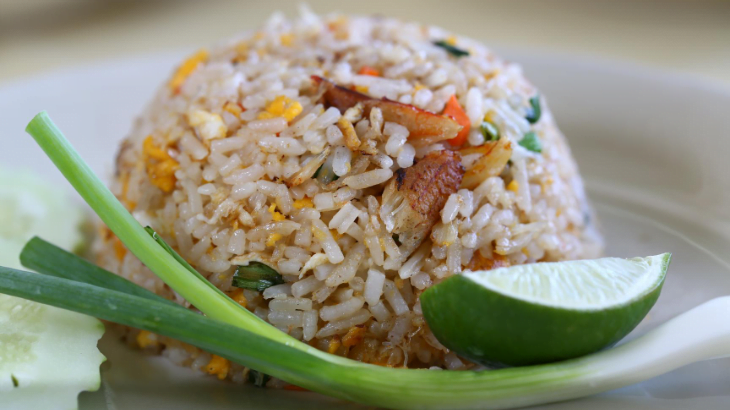Rice starch is densely packed with calories, and it is not possible to remove the starch without destroying rice completely. Luckily though, there are ways to reduce the food energy you get from eating rice. Read on to discover 3 methods you can use to cut starch calories from rice.
Starch in Rice
The calories in rice primarily come from starch, which is one of the three major types of carbohydrates (the other two being sugar and fibre). By weight, starch makes up about 60% of uncooked rice and approximately 30% of cooked rice. When rice is cooked, each grain absorbs water so that the amount of starch is “diluted” by volume.
From a dietary perspective, starch comes in two forms: the first type is easily digested, and the second is the resistant type which cannot be digested by humans. The easily digested type of starch quickly finds its way into the bloodstream whilst the resistant type moves deep into the gut where it nourishes the “good” bacteria found there. Rice contains both digestible and resistant starch.
It is good to remove the digestible starch from rice, if you would like to eat less-fattening rice.
Cut Starch out
Carbohydrates, in the form of starch, are usually the main source of excess calories in unhealthy diets. Simply put, starch is carbs and carbs must be reduced if your aim is to sustain a calorie deficit to lose weight. Without further ado, here are the 3 methods to cut the calories you absorb from rice starch:
Method 1: Dilute your Rice
The best way to reduce the calories from rice is to eat fewer of them in the first place! You can do this by either reducing your rice portion size, or by mixing low-calorie “fillers” into your rice.
The problem with simply eating less is that you will feel less sated, both physically and mentally. The stretch receptors in your stomach will not signal to your brain that enough food has been eaten, so you will remain hungry even if you have had enough.
Trick your Stomach
The best way to trick your stomach whilst adding healthy foods to your diet is to increase your vegetable intake to compensate for the reduced rice portion. Chop up a bunch of carrots, or leafy vegetables like red cabbage or kale, cook as preferred, then mix and shake the lot into cooked rice. The vegetables and air from the mixing process will add lots of volume to the rice, so that you can eat the same “amount” whilst reducing the volume of rice.
Remember to use low-calorie vegetables or meat to dilute your rice. Crumbled cauliflower will work much better than grated potato!

Method 2: Make the Rice Starch Indigestible
Food scientists have long known that the process of cooking changes the chemistry of food in many varied ways. The way you cook and prepare rice has a big impact on the amount of digestible starch it will contain when you eat it. Prepared a specific way, it is possible to cut the amount of easily digested starch by up to 50% for some rice types. Here’s how:
Add Coconut Oil
Add two teaspoons of coconut oil to every cup of raw rice you cook. The oil must be added to the rice from the start of the actual cooking process, so that they cook together. Some of the oil will bind with some of the starch in the rice, changing its chemical content. After the rice is cooked, it must be cooled down completely to room temperature or below. During the cooling process, the starch/oil combination undergoes chemical changes to form an amylose lipid complex, otherwise known as resistant starch (the indigestible type).
There is still lots of digestible starch in the rice, and of course there are added calories from the coconut oil, but weight-for-weight, rice cooked in this way has significantly fewer digestible calories than regular boiled/steamed rice.
Re-heating the cooled rice will not reverse the process, so you don’t have to eat it cold to access the calorie savings.
As an aside, this process works for other types of starch-containing foods as well, but care should be taken with the amount of oil added, as oil calories can easily swamp the starch-change benefits.
Method 3: Get rid of Loose Starch
A third way to reduce the calories you get from eating rice starch is also related to reducing the amount of digestible starch. When you add water to uncooked rice, the water becomes cloudy with tiny white particles which are washed off the outer surface of each grain. These tiny bits of rice flour have an extremely high starch content and they are easily digestible.
How do we know that this rice powder is more fattening than rice grains? Because over many years, in human cultures which have cultivated and eaten rice for generations, it is common knowledge that sickly people with poor digestion can be sustained with it. A common home remedy for upset stomachs and feverish children is to give them cooled rice water which sustains their energy levels through the illness.
If we know that rice has both resistant and digestible starch, and that the loose powder that comes off rice is easier to digest than rice grains, then perhaps the powder has a higher proportion of digestible starch than the grains. Alternatively, it is simply easier to digest because it is in a “pre-chewed” powder form. In any case, it cannot hurt to get rid of it before you eat the rice!
Rinse Rice thoroughly
To get rid of loose rice starch, simply rinse it well before cooking, so that the water poured off it runs clear instead of cloudy. If you have enough time, try par-boiling your rice, then rinse and cool, then cook to completion.
Combine all for Low Calorie Rice Starch
To make low-calorie rice and get the maximum effect of reducing digestible rice starch use all three methods in combination. First, rinse the rice until the runoff water is clear. Then, boil the rice in water for three minutes. Take the rice off the heat and rinse well in cold water, until the runoff is clear again. Mix in two teaspoons of coconut oil for every cup of uncooked rice, then return the rice to low heat until steamed through. When cooked, allow the rice to cool completely. Before serving, reheat and mix in a portion of chopped, cooked low-calorie vegetables.









